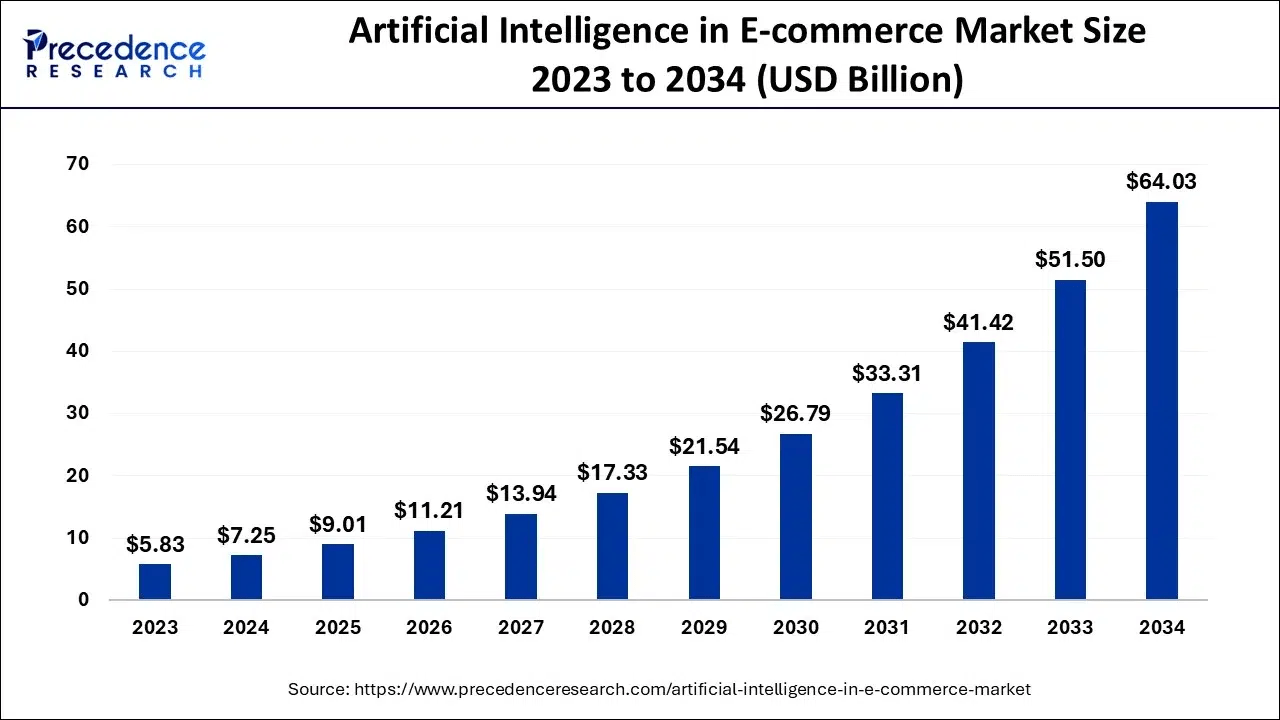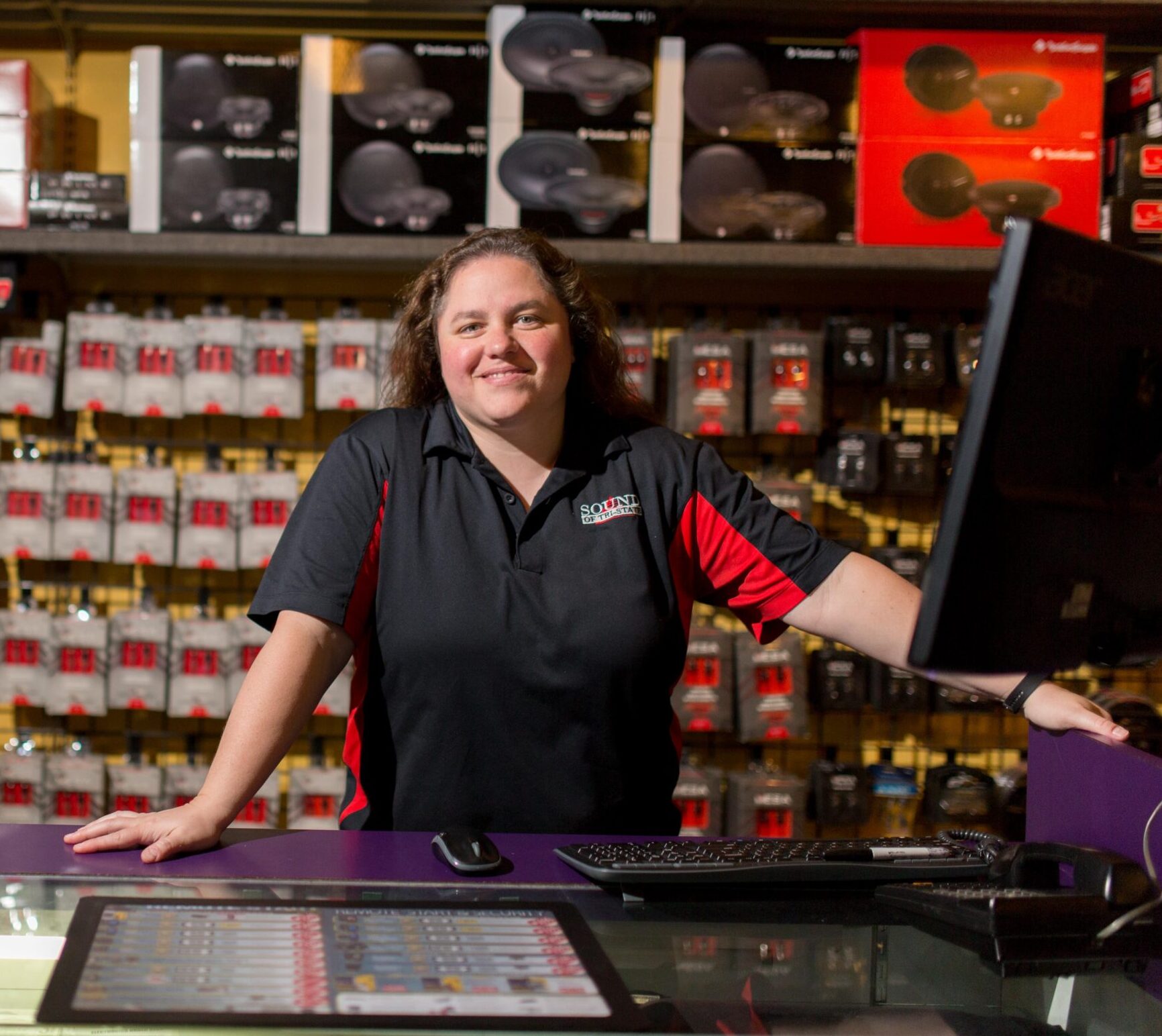
Hyper-Personalization in e-commerce: New Opportunities for Your Business.
Date
The active implementation of AI has not escaped the transformation of the e-commerce sphere – online sales have reached a completely different level. We are no longer talking just about timely delivery or a wide range of products. An online buyer expects a brand to know his needs even better than himself. And if you do not take into account the entire range of possible preferences and wishes of customers – you are unlikely in the top three.
According to research, the use of artificial intelligence in the e-commerce market in 2024 was estimated at $ 7.25 billion, in 2025 it will grow to $ 9.01 billion, and by 2034 it is predicted to exceed the mark of $ 64.03 billion.
This graph illustrates how quickly the market will develop in the upcoming future.

Artificial intelligence in e-commerce is expected to become even more sophisticated, more accurately predicting customer intent and adapting to changing behavior in real time. This evolution is a natural extension of the data-driven personalization that many retailers already practice, but at a much deeper and more scalable level.
Business no longer speaks to everyone the same way. Business speaks to everyone personally.
We live in a time when advertising or mailings sent “to everyone” only cause irritation. Consumers expect the platform to “learn more” about them personally, take into account what things they looked at, when they last made a purchase, which brands resonate with them the most.
And this is where hyper-personalization will help you – an approach that allows you to create a unique approach for each of your customers.
What is hyper-personalization and how does it differ from “regular” personalization?
Most e-commerce brands already have some level of personalization — for example, sending the customer’s name in email templates or recommending products based on browsing history.
Hyper-personalization goes much further. It uses artificial intelligence to analyze user behavior in real time, takes into account geolocation, context, data from different channels — and provides the customer with the most relevant content right now.
For example: Instead of the standard “You might like this dress” — the platform gives a more tailored option for the customer: “This jacket will go with your previous purchase of this dress. By the way, it is currently on sale, and shipping is free until the end of the day.”
Hyper-personalization is based on a combination of several types of data:
- Behavioral data: how users interact with your website or app;
- Transactional data: purchase history, loyalty rewards, return history, reviews, and payment preferences;
- Contextual data: time, location of the customer, and the type of device they are using;
- Social data: likes, shares, comments, and interests on social platforms.
Why is the implementation of hyper-personalization now becoming crucial?
1. The user is overwhelmed with choice. A person sees thousands of offers per day. Their brain automatically blocks what does not respond and does not catch their attention at first glance. And here hyper-personalization is your chance to break through the information noise.
2. Marketing is becoming more expensive. The cost of a click, a lead, or attracting a new customer is only increasing. At the same time, retaining a customer is many times cheaper. But retaining a customer today is not just about “sending letters with promotions.” It is about knowing what the customer needs before he realizes it himself. And hyper-personalization is about value and retention without aggressive promotion.
3. Competition is no longer only with local players. When a user goes to Amazon, Temu, or Zara, he sees personal recommendations, a selection “based on what he has viewed,” or even enters his own shopping world, tailored just for him. And the user gets used to this level. And even if you’re a local business with great service, you’re already competing with those who have the money to implement AI. But hyper-personalization doesn’t have to be expensive, it just has to be smart. Start simple – use the tools that are already available, experiment, and tailor your strategies to your business.

What is the business profit?
- Increased LTV (lifetime value) — When you communicate with a customer in their language — they stay with you for a long time. Hyper-personalization allows you to not just sell something once, but to build long-term relationships: Today you offer them a new model of sneakers. – A week later — accessories for them. – Next month — a new collection, focusing on their style and budget. Each purchase becomes a logical continuation of the previous one. This forms a behavioral habit — and the customer returns again, because he knows: he will get what he needs from you right now and according to his taste.
- Fewer abandoned carts — According to statistics, more than 70% of carts in e-commerce remain “unclosed”. But with hyper-personalization, you don’t just remind them, “You forgot something,” you say, “This item is still waiting for you in your cart—and today it’s 10% off. By the way, shipping is free. Still hesitating?”
There are also additional interaction options – use dynamic banners, push notifications, personalized emails with relevant additions (up-sell and cross-sell). This effectively changes the dynamics: at the same time you do not pressure, but help to complete the logical step towards purchasing the product.
- Better retention indicators – When the user sees that you “know” him, take into account his tastes, lifestyle, location and even mood (yes, AI already knows how to do this), he does not see the point in wasting his time and looking for an alternative elsewhere. He buys from you. In such conditions, retention is not just a cold metric. It is the basis of your business.
- More effective advertising – precise targeting = less costs. Traditional approach: launch a campaign to 100,000 users with the hope that at least 1,000 will respond. Hyper-personalized approach: you know who to show a promotion on sneakers, who to show a dress, and who to show an extra gift wrap because they are buying for someone else.
AI allows you to launch mini-campaigns, based on collected and analyzed data, that cost less, work better, and give a much higher ROI. The result is less spending and more sales. A dynamic AI system can constantly improve the approach, suggesting relevant products and offering timely incentives. As a result, retailers see higher conversion rates and stronger brand advocacy in real time.
Where to start implementing hyper-personalization in your business?
Here is a short roadmap for those who plan to implement hyper-personalization in their business:
1. Evaluate the collected data. What do you really know about your customers — and how can you use it?
- Check the data sources: website analytics, CRM, email platforms, social networks, advertising.
- Conduct an audit: what data is duplicated, what is incomplete, what is not collected at all.
- Try to build a “customer map” using the example of one user: what he saw, what he bought, what he clicked on, what he did not react to. If it does not work out, the data needs to be structured in more depth.
2. Choose an MVP channel. Choose the channel with the highest engagement: website, email, mobile app, push notifications. Segment your audience minimally: new users, those who bought 2+ times, those who didn’t buy anything but viewed products. Don’t try to personalize everything at once. Start small, but work through each step carefully.
3. Connect a CDP (Bloomreach, Segment, Insider) or build a minimal data architecture – manually connect CRM, email, web analytics. Let at least 3 main systems exchange data. Create a unified user identifier: ID, email, phone number – something that allows you to “stitch” customer behavior between channels.
Set up the first personalized scenarios. Launch basic personalization: product recommendations on the main page, personalized blocks in email, triggers for abandoned carts. Don’t forget about effective and high-quality copywriting: personalization is not just a “name in a letter,” but the meaning in each message.
Measure the effectiveness of the selected strategies. Analyze the measured metrics and adapt according to the results. Measure before/after: CTR, conversion, average check, LTV, purchase frequency. Analyze customer behavior: how has the interaction with the site, application or emails changed?
Optimize and scale. What worked – use in the future. What didn’t – change. Now there are enough options for experiments:
- Connect new data sources: chatbots or a mobile application;
- Deepen segments: turn “active users” into “VIPs with a high check in the selected segment”;
- Implement personalization not only in marketing, but also in the product: personal pages, dynamic prices, individual messages in the user’s personal account.
In 2025, hyper-personalization is a must—it’s about surviving in an environment where the user no longer expects convenience—they demand it. And if your brand can’t say “I understand you” on the first click, you’ll lose that customer. Companies that don’t invest in researching their users’ needs and wants are guaranteed to lose market share.
But the future of hyper-personalization isn’t just about better algorithms or smarter AI. Its main goal should be to build trust and build long-term relationships with customers.
Images by Freepik



